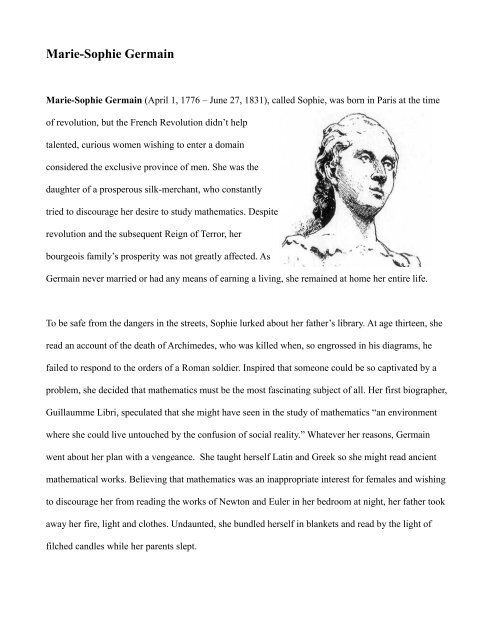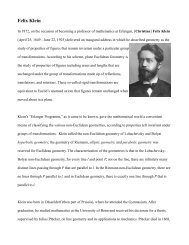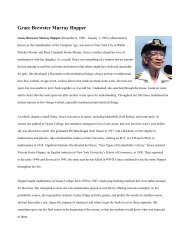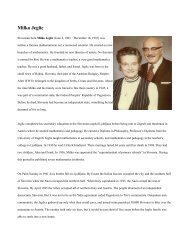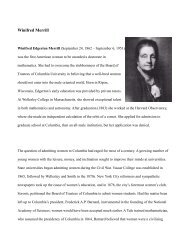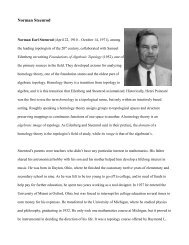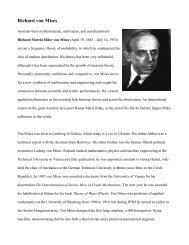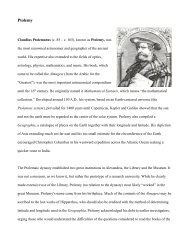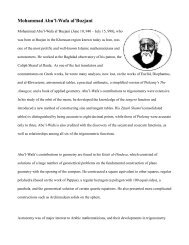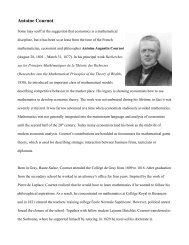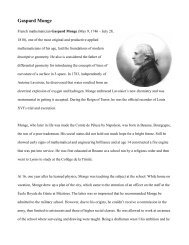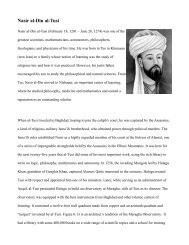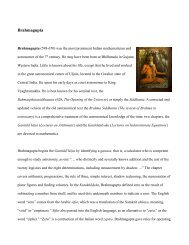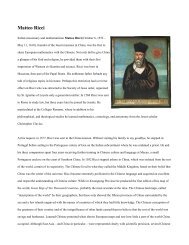Marie-Sophie Germain
Marie-Sophie Germain
Marie-Sophie Germain
- No tags were found...
Create successful ePaper yourself
Turn your PDF publications into a flip-book with our unique Google optimized e-Paper software.
Eventually <strong>Germain</strong>’s father lessened his opposition to her study of mathematics. When she waseighteen, the École Polytechnique was established as part of the revolution’s educational reforms, butthese didn’t extend to admitting female students. Although <strong>Germain</strong> was denied the privilege ofattending the École, she was able to obtain the lecture notes of some male students. Assuming theidentity of a male student, “M. Antoine August LeBlanc,” <strong>Germain</strong> submitted a memoir on analysis toJoseph-Louis Lagrange, which he found so outstanding he wanted to meet its author. When hediscovered the paper was the original work of a woman, he became her sponsor and introduced her tothe company of mathematicians and scientists that she could never have aspired to meet on her own.Since she was could not take the route of male students, she proceeded on her own course of study withthe result that her mathematics education was somewhat disorganized and directionless.Intrigued with Carl Friedrich Gauss’ number theoretic work in his Disquisitiones Arithmeticae,<strong>Germain</strong> wrote a dozen letters to him between 1804 and 1809, describing her own efforts in the field,including her attempts to solve Fermat’s Last Theorem (FLT). She again used the pen name “M.LeBlanc,” fearful that if it were known she was a woman, she would be ignored. Gauss praised herproofs and spoke highly of M. LeBlanc’s accomplishments in letters to other mathematicians. The twonever met, and it wasn’t until after the French troops occupied Gauss’ hometown of Braunschweig thathe learned her true identity. Concerned that Gauss might experience Archimedes’ fate, <strong>Germain</strong>contacted a family friend, General Pernety, gaining his assurance that no harm would befall the greatmathematician. When Gauss was told that the intervention on his behalf was due to <strong>Sophie</strong> <strong>Germain</strong>, heinsisted he knew no such person. Finally she wrote, confessing that she was “M. LeBlanc.” WhenGauss learned that his correspondent was a woman he was even more generous in his praise.“A taste for the abstract sciences in general and above all the mysteries of numbers is excessivelyrare: one is not astonished at it; the enchanting charms of this sublime science reveal themselvesonly to those who have the courage to go deeply into it. But when a person of the sex, which,
according to our customs and prejudices, must encounter infinitely more difficulties thanmen to familiarize herself with these thorny researches, succeeds nevertheless insurmounting these obstacles and penetrating the most obscure parts of them, then withoutdoubt she must have the noblest courage, quite extraordinary talents and a superior genius.Indeed nothing could prove to me in so flattering and less equivocal manner that theattractions of this science, which has enriched my life with so many joys, are not chimerical,as the predilection with which you have honored it.”<strong>Germain</strong> wrote to Adrien-<strong>Marie</strong> Legendre concerning her work on Fermat’s Last Theorem. Impressed,he credited her with what is now known as <strong>Germain</strong>’s Theorem in a footnote in the second edition ofhis book Essai sur la Théorie des Nombres. The theorem states that in the case when n is equal tocertain prime numbers, now called <strong>Germain</strong> primes, the equation x n + y n = z n probably has no solutions.<strong>Germain</strong> primes satisfy the condition that if n is prime, then 2n + 1 must also be a prime. The first few<strong>Germain</strong> primes are 2, 3, 5, 11, 23, 29, 41, 53, 83, 89, and 113. In an elegant proof, she showed that if nas such a prime, then one of the three values x, y or z must be a multiple of n, greatly restricting thepossible values for a solution. Not having access to computers, <strong>Germain</strong> had considerable difficulty indetermining when p and 2p + 1 are both primes. As of 2003 the largest known <strong>Germain</strong> prime consistsof 34,547 digits. <strong>Germain</strong>’s theorem separated FLT into two cases, for numbers not divisible by 5 andfor those that were divisible by 5. As a result the possible instances when FLT might fail for primes lessthan 100 were reduced to case number two. In 1825, Legendre and P. G. Lejeune Dirichletindependently based their proofs that the case of n = 5 had no solutions using her techniques. In 1839Gabriel Lamé made some ingenious additions to <strong>Germain</strong>’s method and proved that FLT had nosolutions in the case of n = 7.When German physicist Ernst F.F. Chladni visited Paris in 1808, he demonstrated the curious patternsproduced on small glass plates covered with sand, which could be played like violins with a bow. The
sand moved about until it reached the nodes. Napoleon authorized the French Academy of Sciences tooffer a prize for the best mathematical explanation of this phenomenon. The challenge was to“formulate a mathematical theory of elastic surfaces and indicate how it agrees with empiricalevidence.” Most mathematicians ignored the contest, believing the mathematics needed to formulatesuch a theory didn’t exist. <strong>Germain</strong>’s anonymous 1811 entry was the only one, and her lack of a formaleducation was evident, so she did not win the prize. The judges found mathematical flaws in herargument, noting that she had not derived her hypothesis from principles of physics. <strong>Germain</strong>’s selfstudydidn’t include the mathematical methodologies appropriate to the molecular structure theory formaterials, then in vogue. However, these methods were of no use in explaining the phenomena inquestion, so <strong>Germain</strong> brought original insights to the problem.The judges, especially Lagrange, admired <strong>Germain</strong>’s originality. He corrected an error in hercalculations and devised an equation that he thought might describe Chladni’s patterns. The deadlinefor submitting theories was extended two more years. Once again <strong>Germain</strong> was the only one to submitan entry. In it, she demonstrated that Lagrange’s equation yielded Chladni’s patterns in several cases,but because she was not able to offer a satisfactory derivation of the equation from physical principles,her work received only an honorable mention. The contest was reopened in 1815, at which time<strong>Germain</strong>’s third attempt was deemed worthy of the prize, although still considered lacking in rigor.Though this was the high point of her scientific career, she did not attend the award’s ceremony,believing that the judges did not fully appreciate her work and that the scientific community did notshow her the proper respect. <strong>Germain</strong> continued to work in mathematics until her death from breastcancer, at age 55. She died before an honorary doctorate in mathematics from Göttingen, arranged forher by Gauss, could be awarded.Quotation of the Day: “Algebra is but written geometry and geometry is but figured algebra.” –
<strong>Sophie</strong> <strong>Germain</strong>.


